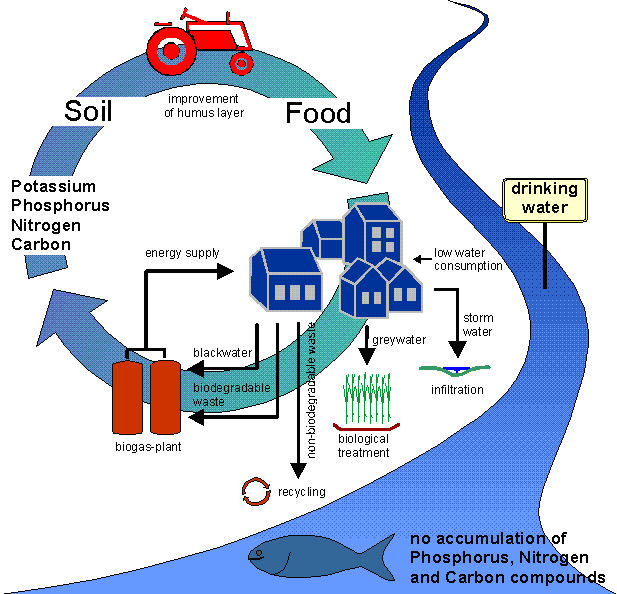Category:Sanitation
You can Categorize an article by putting a [[Category:Sanitation]] tag in the text of the page.
Ecological sanitation
Introduction
Ecological sanitation can be viewed as a three-step process dealing with human excreta: (1) Containment, (2) Sanitisation, (3) Recycling. The objective is to protect human health and the environment while limiting the use of water in sanitation systems for hand (and anal) washing only and recycling nutrients to help reduce the need for artificial fertilisers in agriculture. An essential step in the process of sanitation is the containment of pathogens that can cause disease. Without containment and sanitisation, a vicious circle develops where the pathogens in excreta are released back into the environment, re-infect people through consumption of contaminated water or food, and are then excreted again, only to begin the cycle over. Ecological sanitation systems are designed around true containment and provide two ways to render human excreta innocuous: dehydration and decomposition. The Ecosan concept is based on following principles:
- Prevent diseases (must be capable of destroying or isolating faecal pathogens)
- Protect the environment (must prevent pollution and conserve valuable water resources)
- Return nutrients (must return plant nutrients to the soil)
- Culturally acceptable (must be aesthetically inoffensive and consistent with cultural and social values)
- Reliable (must be easy to construct and robust enough to be easily maintained in a local context)
- Convenient (must meet the needs of all household members considering gender, age and social status)
- Affordable (must be affordable and accessible)
Ecological sanitation is an alternative to the linear approaches to carry waste (excreta, soapy water, etc.) to water bodies. It is based on an ecosystem approach. The nutrients and organic matter contained in human excreta must be considered as a resource and properly treated for its contribution to food production systems. Systems typically work with urine-diverting dehydration toilets (often with soil-'flush'), flush-urine-diversion toilets and black water systems for example based on the vacuum toilets connected to a biogas plant.
Figure 1 illustrates a possible scenario for closing the nutrients cycles and simultaneously preserving fresh water from pollution. This scenario can be achieved with the application of ecological sanitation, base on ecological principal.
Pages in category "Sanitation"
The following 41 pages are in this category, out of 41 total.
H
- How to Build a Compost Toilet
- How to Build a Rainwater Tank: Sri Lankan Pumpkin Tank
- How to Build a School Building in Developing Countries
- How to build a Ventilated Improved Pit Latrine
- How to Build an Underground Brick Dome Water Tank
- How to Build Dry Toilets
- How to Build Emergency Camp Toilets
- How to Build the ARTI Compact Biogas Digestor
- How to Control Water Hyacinth
- How to Design and Maintain Food Processing Equipment to Prevent Food Poisoning
- How to Dry Fruits, Vegetables, Herbs and Nuts
- How to Filter Water with a Sand Filter
- How to Grow a Banana Circle
- How to Grow Moringa Trees
- How to Harvest Rainwater
- How to Harvest Water
- How to Heat Water with Sun Power
- How to Home Compost
- How to Lower Water Turbidity with a Roughing Filter
- How to Make a Coffee-Clay Water Filter
- How to Make a Tippy Tap for Hand Washing
- How to Pasteurize Water with a Plastic Bottle
- How to Recycle Organic Waste
- How to Recycle Plastics
- How to Start an Article
- How to Start Composting
- How to Stock Water in Cement Water Jars
- How to Test if Water Is Pasteurized
- How to Use the Porous Clay Pots and Pipes System
